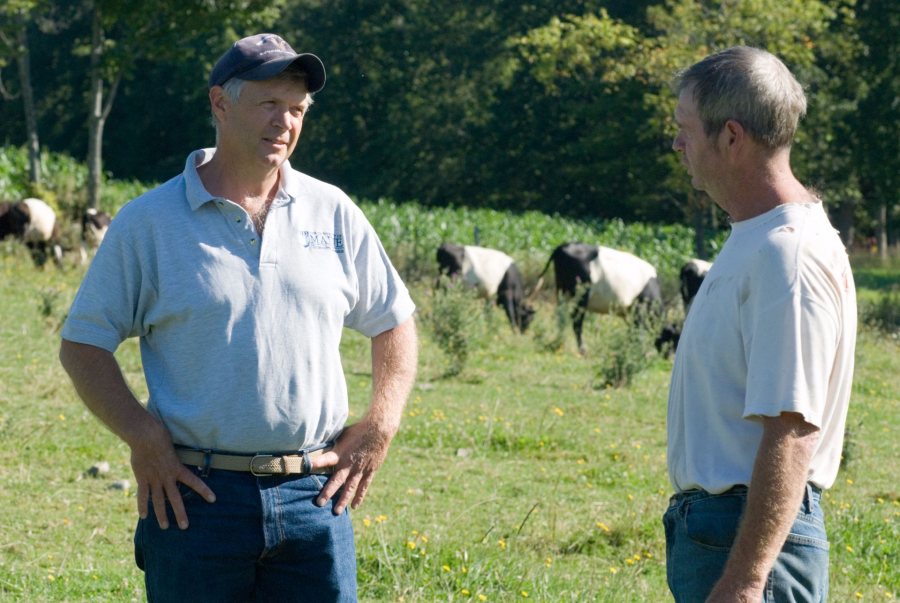The measures farmers can take to protect water and soil are well-known, says Francis Eanes, a visiting assistant professor of environmental studies at Bates.
What’s less understood, he says, is “what sorts of cultural, social, and economic factors motivate any given farmer to actually implement those practices on their farm.”
It’s likely that farmers are influenced in overt ways. The federal Natural Resource Conservation Service, for example, gives farmers advice and financial incentives to reduce pollution.
Now, according to a study led by Eanes and published in the journal Environmental Management in November, we know of another potential influencer not normally associated with conservation: crop advisers.

Visiting Assistant Professor of Environmental Studies Francis Eanes poses in his Hedge Hall Office. (Phyllis Graber Jensen/Bates College)
Crop advisers work independently or for retailers like seed or fertilizer companies, helping farmers be more productive and efficient.
Because advisers offer value, farmers are likely to follow their advice, Eanes says.
“Farmers believe these folks understand the agronomics,” he says. Advisers “understand the context, and they’re working in the best interest of the farmer.”
That’s also the experience of Rick Kersbergen ’78, a crop adviser certified by the American Society of Agronomy who specializes in dairy farming in Maine. He says farmers trust the advice they’ve paid to get.
Kersbergen, an extension professor for sustainable dairy and forage systems with the University of Maine Cooperative Extension, has helped Maine dairy farmers go organic in recent years and researched pasture and forage systems for dairy cows, farm safety, and soil health. While he still works directly with dairy farmers, he now also runs seminars, helps would-be crop advisers study for the certification exam, and provides recertification training.
Kersbergen says farmers turn to crop advisers for all manner of farm management decisions.
“The trend has been for farmers to hire crop advisers to provide pest management advice as well as manure, nutrient, and herbicide-pesticide advice,” he says.

Rick Kersbergen ’78 (at left), a professor at the University of Maine Cooperative Extension, visits an organic dairy farm. (Courtesy of Rick Kersbergen)
That influence, Eanes and a team of coauthors found, could be directed to conservation. Before coming to Bates, he completed a postdoctoral fellowship at Purdue University’s National Resource Social Science lab, which has explored more generally how to get farmers to adopt conservation practices.
In collaboration with The Nature Conservancy, the group surveyed farmers in the Saginaw Bay region of Michigan’s Upper Peninsula, where phosphorus and nitrogen from farms can get into waterways and end up in the Great Lakes, creating algae blooms and dead zones.
Crop advisers can and often do help farmers with conservation. The advice is just not framed that way.
They asked the farmers how likely they were to follow crop advisers’ recommendations on “conservation” generally, and how likely they were to follow crop advisers’ recommendations on specific practices that are relevant to other aspects of farm management.
For conservation advice, farmers said crop advisers were only “somewhat influential,” the surveyors found. But farmers said crop advisers were “very influential” on their decisions to adopt practices related to soil testing and crop disease — practices that themselves help reduce pollution.
The results tell Eanes that crop advisers can and often do help farmers with conservation. The advice is just not framed that way. For example, crop advisers often recommend variable-rate nutrient application, which means applying fertilizers where they’re most needed in a field. It’s better for the environment and for farmers’ yields.
“Where production and conservation practices overlap is where I think crop advisers have the largest potential to be influential,” Eanes says.
Though Eanes’ study focused on the Midwest, it’s easy for Kersbergen to see the same overlap in New England. Many conservation practices make sense from a production or financial standpoint — for example, the requirements for organic or non-GMO certification often have a conservation component.
The problem is that it can be difficult to see an immediate return on a conservation-related investment.
“When we talk about conservation on a farm, we’re talking about resources we’re trying to protect — whether land, soil, water, or air — which are integral for farmers to survive,” Kersbergen says.
“The real issue for most farmers, at least a lot of farmers I work with, is that the financial implications of conservation don’t necessarily show themselves in the short term.”
Eanes thinks conservation-focused nonprofits and government agencies should work directly with crop advisers to steer farmers toward practices that both improve yield and reduce pollution.
And according to a second study that Eanes says will be published next year, crop advisers might be on board.
“They love conservation practices and see themselves as being really influential on farmers’ decision-making,” he says.
The hurdle, Eanes says, is that conservation agencies often don’t engage crop advisers to help shape the agencies’ own programs. There are also “institutional differences,” he says.
“Crop advisers see themselves in the private sector as being much more nimble and moving very quickly,” Eanes says.“They see conservation programs as being bureaucratic, very paperwork-dominated.”
Nevertheless, as both cooperative extension services and other public agencies that promote conservation shrink, crop advisers may be the only ones who can reconcile government regulations, farmers’ economic and production needs, and the health of the environment.
“For farmers to stay viable given the resources we have, conservation needs to be a big part of their whole farm system,” Kersbergen says.


